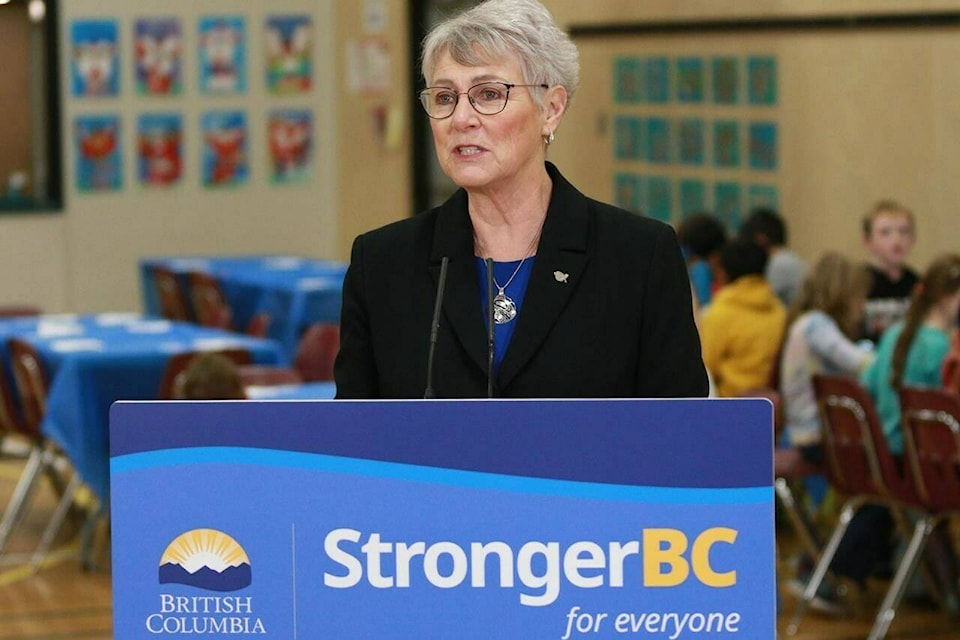Snow blanketed the provincial capital in the morning hours of B.C.’s budget day, but David Eby’s New Democratic government plans to make it rain in the upcoming fiscal year.
Finance Minister Katrine Conroy presented the 2023-24 budget Tuesday (Feb. 28), saying this year’s budget helps protect people who can’t afford high prices and takes action on issues people care about like finding affordable housing and accessing health care.
But the budget is also short on key details, including future deficits, and warns of potentially rough economic winds ahead.
Highlighted spends include: $1 billion in one-time grants for municipalities, $199 million of new money for mental health, addictions and treatment services and the long-promised, long-delayed renter’s rebate, albeit in form of a credit, of up to $400 per year.
Costs to taxpayers
British Columbians will feel pain at the pump thanks to a large bump in the carbon tax, a development likely not welcome in many parts of the province without extensive public transit systems.
Starting April 1, the tax will increase by $15-per-tonne of carbon dioxide each year until it reaches $170 in 2030.
It currently sits at $50-per-tonne.
The increase means that the tax’s share on a litre of gasoline will rise to 37.4 cents by 2030 from just over 11 cents today.
This increase is perhaps the most significant pocket-issue for British Columbians coming out of a budget that is some $4.2 billion dollars in the red thanks to nearly $80.2 billion dollars worth of estimated spending. About $4.7 billion is new spending starting April 1.
Estimated revenues for 2023-24 are down nearly $5 billion from the latest forecast as the provincial government expects B.C.’s economy to grow by 0.4 per cent in the 2023 calendar year, thanks to the conflict in Ukraine and other economic factors such as interest rates.
But dark clouds on the economic horizon are not stopping the provincial government from spending another $3.7 billion before March 31, with $2.7 billion requiring legislative approval outside the regular budget process.
This funding includes the $1 billion for one-time grants for municipalities announced in February.
The rest — $500 million for the renters protection fund announced in January 2023 and $500 million for an additional affordability credit for families— does not require legislative approval because it falls under existing legislation.
B.C. will finish the 2022-23 fiscal year with a surplus of $3.6 billion, which is $2.1 billion lower than the earlier forecast of $5.7 billion.
Coming years will see the province runs deficits of $3.75 billion in 2024/25 and $3 billion in 2025/26 — or more than $11 billion over three years, starting this year.
Conroy is not fazed. While B.C.’s debt-to-GDP ratio will increase from an estimated 27 per cent in 2023/24 to 31.1 per cent in 2025/26, the province remains in strong financial shape compared to others, she said, adding that government is taking a measured approach.
Key areas of new spending for the upcoming fiscal year include health care and mental health, housing and a smorgasbord of new measures to reduce costs.
Health care and mental health care top budget spend
Nearly 49 per cent of new spending (including contingencies) in the 2023-24 budget will go toward health care and mental health, where the government will spend $199 million of new money for mental health, addictions and treatment services.
Over three years, the government plans to spend $867 million on mental health, addictions and treatment services in responding to the overdose drug crisis.
But the budget, despite the additional spending, does not fulfil long-standing demands that the province cover the cost of psychological services. Additional monies, however, might be coming from the federal government.
$4.2 billion on increasing housing supply, reducing homelessness over three years
Roughly 24 per cent of the new spending budget — some $1.08 billion —will go toward housing, with almost $400 million going toward building new homes.
Over three years, the government plans to spend almost $4.2 billion on new measures to increase the housing supply and reduce homelessness.
The government, however, remains vague about how much new housing it plans to build. It speaks of thousands of new units, but does not give a specific figure. Conroy told reporters Tuesday that details will be announced in the future.
She also said that government will continue to work with the private sector when it comes to building more housing in face of higher interest, labour shortages and figures that show new housing starts declining before levelling off.
Cost-of-Living highlighted
Another quarter of the Eby government’s new spending in 2023-24 will go toward reducing costs. Some of those measures are new spending to finance free prescription contraception, increased supports for individuals on income and disability assistance, and K-12 school food programs.
Other measures include a long-promised, long-delayed renter’s rebate, albeit in form of a credit, of up to $400 per year. The government promises that 80 per cent of renter households will be able to get a break.
But the credit comes with a catch: it won’t come into effect until 2024.
Households that make less than $60,000 per year will be able to claim the full credit, while households earning as much as $80,000 per year will be able to claim a partial amount.
The government also promises to help offset the tax increase by raising the climate action text credit and promises that a significant, unquantified majority of British Columbians will receive more back than what they pay.
The government has set itself the goal of reaching 80 per cent of all households through the credit.
@wolfgangdepner
wolfgang.depner@blackpress.ca
Like us on Facebook and follow us on Twitter.
